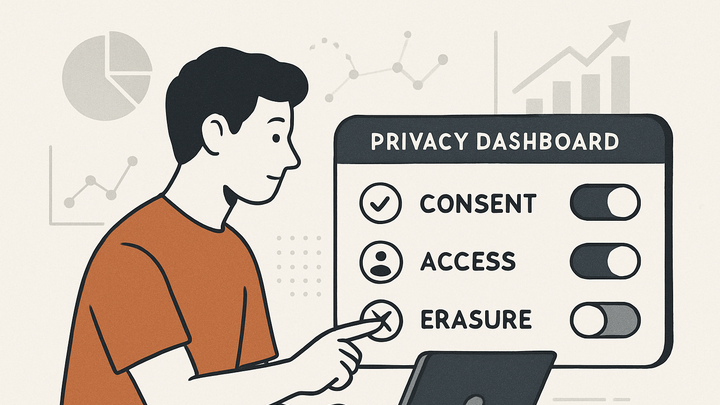Published on 2025-06-26T04:31:28Z
What are Data Subject Rights? Examples for Analytics
Data Subject Rights are the legal entitlements granted to individuals over their personal data. In the analytics industry, these rights ensure transparency, control, and trust between data subjects and organizations collecting behavioral data. Respecting these rights means every analytics implementation must be designed to facilitate requests like data access, erasure, and portability. With regulations like GDPR and CCPA, analytics teams must understand how to embed consent mechanisms, ensure data deletion workflows, and support user-driven data export. This article explores the key rights, shows how platforms like PlainSignal and GA4 support compliance, and offers best practices for analytics teams to build privacy-first data processes.
Data subject rights
An overview of individuals’ data subject rights in analytics, with examples of compliance in PlainSignal and GA4.
Understanding Data Subject Rights
Data Subject Rights are legal entitlements granted to individuals under privacy regulations. These rights define how organizations can collect, process, store, and share personal data. In analytics, understanding these rights is crucial to designing compliant data collection and processing workflows. By recognizing these entitlements, analytics teams can build trust, avoid penalties, and ensure transparent data practices.
-
Definition
Data Subject Rights refer to the rights individuals have to access, correct, delete, or transport their personal data held by organizations.
-
Legal framework
Major regulations that establish data subject rights include:
-
Gdpr
The EU General Data Protection Regulation grants residents rights such as access, erasure, portability, and the right to object to processing.
-
Ccpa
The California Consumer Privacy Act provides California residents rights like disclosure of collected data, deletion requests, and opting out of data sales.
-
Key Data Subject Rights under GDPR and CCPA
Both GDPR and CCPA enumerate specific rights that individuals can exercise. Analytics teams must implement processes to honor each of these rights promptly and accurately.
-
Right of access
Individuals can request a copy of their personal data collected by analytics tools.
-
Right to erasure
Also known as the ‘right to be forgotten’, it allows users to have their personal data deleted from systems.
-
Right to data portability
Users can obtain and reuse their personal data across different services in a structured, common format.
-
Right to restrict processing
Individuals can request the limitation of how their personal data is processed, often suspending non-essential processing.
-
Right to object
Users can object to the processing of their personal data for certain purposes, such as direct marketing.
Implementing Data Subject Rights in Analytics
Compliance requires technical and organizational measures within your analytics stack. Teams must plan for consent capture, data deletion workflows, anonymization techniques, and data export capabilities.
-
Consent management
Collect and store user consent choices before any analytics processing begins.
-
Consent banner
Displays a banner that asks for user consent before data collection starts.
-
Preference storage
Stores user consent decisions and applies them consistently across sessions.
-
-
Anonymization & pseudonymization
Transform or mask personal data to reduce identifiability, helping comply with minimal data principles.
-
Data deletion workflows
Automate processes for receiving and fulfilling erasure requests to remove user data promptly.
-
Data export & portability
Enable users to export their data in a structured format, such as CSV or JSON, via self-service tools or APIs.
Example: PlainSignal Cookie-Free Analytics
PlainSignal is a simple, cookie-free analytics platform designed for privacy-first data collection. It minimizes personal data processing and streamlines compliance with data subject rights.
-
Tracking code integration
Use a lightweight snippet that avoids cookies and respects user consent gestures.
-
Integration snippet
<link rel="preconnect" href="//eu.plainsignal.com/" crossorigin /> <script defer data-do="yourwebsitedomain.com" data-id="0GQV1xmtzQQ" data-api="//eu.plainsignal.com" src="//cdn.plainsignal.com/plainsignal-min.js"></script>
-
-
Opt-out mechanism
PlainSignal provides a built-in opt-out parameter that stops all data collection when triggered.
-
Data request api
An API to retrieve, export, or delete user-level analytics data upon verified requests.
Example: Google Analytics 4 (GA4)
GA4 includes features to help organizations comply with data subject rights while maintaining robust analytics capabilities.
-
Consent mode
Allows adjustment of data collection behavior based on user consent signals for analytics and advertising cookies.
-
Data deletion api
Provides endpoints to programmatically delete user-level or event-level data in response to erasure requests.
-
Bigquery export
Enables raw event data export for user-driven data portability workflows.
Best Practices for Analytics Teams
Building a privacy-first analytics culture helps sustain compliance and trust. Integrate policies, documentation, and regular audits into your workflow.
-
Documentation & transparency
Maintain clear records of data processing activities and make privacy policies easily accessible to users.
-
Regular audits & monitoring
Conduct periodic reviews of data flows, consent logs, and third-party integrations to ensure ongoing compliance.
-
Vendor management
Assess third-party analytics and marketing tools for their ability to support data subject rights before integration.
-
User education
Provide clear guidance to users on how they can exercise their data subject rights through dashboards or support channels.
